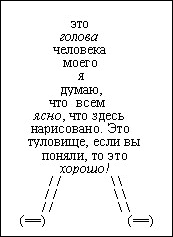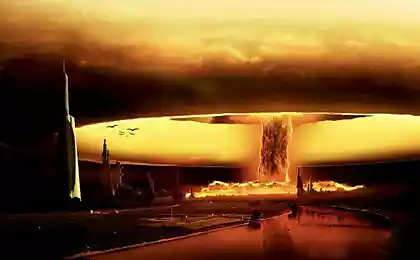628
Bomb for the subconscious
What do you think would happen if two people will tell you different things? One in left ear and another in the right? And there is a very curious thing: no matter how you try, you will be able to recognize only a single text. The other will be unavailable.
Your ears are working perfectly, and you are all great to hear, but to hear you will be the only one of the two proposed options. The second you hear it, too, but don't realize it.

Cerri (Cherry), working with two sources of signals that simultaneously listens to the people (using special headphones in ear serves two different tapes) found the "party" (cocktail party effect) – the ability to listen and learn only one of the two conversations.
Subjects were required to listen carefully to one of the entries, and, in the end, he could easily retell the heard. But from other records it didn't catch almost anything.
The same effect found in the field of visual signals: when the retina of the right and left eyes were served different kieszeni, the subject may perceive only one of them.
But. There are two important things. Even three. First: your subconscious hears both (!) text.
You can compare this with the telephone system protection, "listening" all the talk and including automatic recording when in the air "terrorist" words like "bomb", "attack", "blow up" and so on. This system is a myth, as is the record of all calls, without exception, and the film tapped, if there is a reason. I also doubt very much that terrorists use in the air such words as "bomb", "attack" or "blow up". But it does not matter. It is important that the person has such a defensive system called "subconscious", which controls all the sounds of the ether. This is the first.
Second: at the appearances of these important words, the mind involuntarily switches to this channel, which until that time was not aware of it. For example, sitting the representative of the faction of the FBI listening to phone conversations of potential terrorists. Lines a lot, and listen to only one physically possible. Here he sits and listens, as the worst terrorist orders pizza, and suddenly – Bang! – hears the word "bomb", which is on the other line. Focus is automatically switched to the conversation, and order pizza from the consciousness of "fall."
Third: we may freely switch from one channel to another. For example, the FBI listens to the conversation about "the bomb," and realizes that a potential terrorist tells of a beautiful woman. And that's all. Now he can "return" their attention to the pizza if he wants. Or continue to listen to a conversation about women.
If the FBI agent to ask about what was discussed during the second conversation to the word "bomb", he won't be able to remember anything. But if the agent ask what was discussed in the first conversation, after the word "bomb", he won't be able to remember anything. How would the psychologists didn't say no "tape recorders" that record everything in our head no. And if you don't listen to the conversation, you will not be able to remember. Even assuming that it is "heard" by your subconscious. Because its behavior resembles the above-mentioned system of protection from terrorists. As soon as sounds is the key word, the recording. But if a word is not sounded, the conversation is ignored. The agent will be able to recall a conversation about a pizza and the words "bomb" and talking about "the bomb" after the word "bomb". The second part of the first conversation and the first part of the second conversation in his memory does not exist.
Why am I so detailed about this? Because, through the efforts of neurolinguistic programming in advertising appeared obsession "programming" the subconscious mind of the client by using special keywords. It is called the "inserted appliances". Ad text is artificially inserted another text that was written by another size, another color, in bold or italics. When the client reads the text "inserted" words subconsciously (!) formed in a separate text, and the client actually reads the hidden message. This is often imperative. For example, buy from us. That's the theory. Does it work? Let's deal.
The technique of the inserted messages is the ancestor of the technique of the inserted message was the eminent psychoanalyst Carl Jung (student of Freud, author of the famous theory of the collective unconscious, which is reflected in the advertisement). Jung offered the client a set of words that the client had to respond in some free Association. For example, the word "mother."
And the client says what he experiences. But the point was not in what the client offers in the word "mother" "father" or "childhood". Jung observed which words cause unexpected difficulties with associations. If the word "cat" the client could not find an Association, Jung suggests that the cat is somehow connected to the client with the painful experiences of the past. For example, when the client was small, the cat scared him or scratched him. And if the Association comes easily, then there is no problem. Thus, Carl Jung identified the traumatic memory of the distant past, and without knowledge of the client. And while other analysts "searched" the problem, Jung found it in a few minutes, which allowed him to work precisely.
In 1936, Milton Erickson, world-renowned psychotherapist and hypnotist, has written an article in which he described the result of the experiment with the test of Jung. The subject was a young woman with the fear of pregnancy. In their study, Erickson showed her the stimulus word "belly," and received in response to the story, but some words from this text bilichek would be bold. For example, changes the intonation. Or made an involuntary gesture. In General, it was obvious that some words are more emotionally saturated than others.
Erikson separated these words from the rest of the text, and he did a related story about unwanted pregnancy (and subsequent abortion): the patient, anxiety, child, fear, surgery, illness, forgotten. Thus, a woman unconsciously told Erickson the story of her past experiences, which later were supplanted and forgotten.
But Erickson went even further. He suggested that this process can be deployed to the contrary. That is, to emphasize a gesture or a tone of some particularly important words. And then the therapist will be able to send to the client the hidden unconscious messages. That's the theory.
A marked message is transmitted to the client in the form of any communication emotionally neutral and matter how does not associated with some traumatic or painful for the client subject. However, in this message there are nested words, which are marked in one way or another. For example, a simplified verbal message for the client suffering from a headache: "our mayor decided that this svetlahrosk will look great if you paint the fence, especially when anaposta". In this case, we have inserted the message head light clear, which can be emphasized or gestures or intonation, or even a different font if it, suppose, written.

The head is clear
Thus, the client receives more than one message, but two. The first focused on consciousness – it is recognized and understood by the client. The second message is addressed exclusively to the subconscious, and is for the attention (consciousness) of the client undetected.
In psychotherapy, it provides an invaluable opportunity to communicate directly with the subconscious on a very deep level, without any of the TRANS and at the time when the client and therapist talking about the flowers or the advantages of one car over the other. Therefore, therapy by the method of false messages can take place absolutely anywhere and not just in the counselor's office. And this is a fantastic opportunity not passed by the views of the advertisers. If it works anywhere, and works in advertising. And to say the consciousness that "cast-iron battery company Tickin is very reliable," and to tell the subconscious mind that "cast-iron battery company Tickin is very safe" – agree, not the same. I would like to the subconscious. And, preferably, without the knowledge of the client.
So today, if you open any directory advertising, newspaper or magazine, you will find advertising texts with obvious signs of false messages. It is implemented using the method of color, font or any other that is distinguishable by eye differences in certain words and advertising appeals. For example? For example, here.
Produced by reliable Russian FURNITURE FOR YOUR OFFICE.
Chairs, armchairs, furniture. Supply of components
for the Assembly seats. Deliver and Assembly.
Flexible discount system, low prices.
Collect all the words (bold, italics, and capital letters) and you will get a second text. It is quite meaningful. Addressed to the subconscious mind of the client. Therapists confirm that this technique works. Erickson, when the receptionist complained of a headache, asked her urgently to print the letter. He dictated, she typed. When the Secretary finished typing the letter, the head is not ill. In the text of the letter was inserted a special word addressed to the subconscious. "Lighter", "it will soon pass", "scatters", "feel good." And the head passes. The real thing.
Does this technique in advertising? No. But if you haven't guessed why, read the article again. Key words: young patients (who took the test), a woman with fear of pregnancy, the Secretary Erickson with a headache. Why it works in these cases but does not work in advertising? Any ideas?
Bomb for subconscious be aware of tracking system for phone calls? If there were words like "bomb" "bin Laden" or "Jihad", the system automatically starts recording. The system has a certain set of words to which it responds. Something similar happens in the test of Jung. Each person has a set of "painful" words, to which he instinctively responds. The only problem is that each person has this set of words is unique. For a woman who is afraid of pregnancy, these words are "patient", "surgery", "disease", "baby" and "belly". Assuming that advertising will feature at least one of these words, the woman's attention, probably fully concentrate on advertising. As in the case of the FBI agent who heard the word "bomb".
But expand this situation to the opposite, and see what we get. The FBI agent hears the word "belly", a woman hears the word "Jihad". And then what? And nothing. The FBI agent did not hear this conversation, and the woman will not pay attention to this advertising. Because these words are for them emotionally neutral.
The difference between the client and therapist's advertising audience is that in the first case – the client is always the same, and in the second case – they are always a lot. And everyone in the subconscious of your list. One cat, the other the stomach, the third poker. And the list will be equal to the size of the biggest dictionary in the world.
How many times will trigger a recording device designed to record the conversation with the word "Jihad"? For example, one time in a million conversations. And how many times will the subconscious to produce the word (see sample ad above) or chairs. Also about once a million readers to this ad. Does this make sense? Any sense. It is necessary to write a good advertisement, not "paste" the message allegedly addressed to the subconscious. In psychotherapy – it works on the five plus. In the advertisement – no. So, don't bother, and use the allocation strictly for one thing: focus is the most important argument, the main idea. Only. How to do it, we now know.
The emphasis in the text and accent the proportions To start, I'll give you one advertisement Tide. It is in English, but we, in this case, it does not matter the content of the text, but only its form. So:
Why do you suppose the manufacturer put a box of Tide in your new automatic?
... So your automatic will give you the cleanest clothes possible!
This text is taken from an advertising leaflet Tide of the sample 50-ies of the last century. Now look again at our Russian announcement of the beginning of the XXI century.
Produced by reliable Russian FURNITURE FOR YOUR OFFICE.
Chairs, armchairs, furniture. Supply of components
for the Assembly seats. Deliver and Assembly.
Flexible discount system, low prices.
I'm not trying to set you on a mystical way, but count the number of words in each text. They will be exactly 25. And now look at the proportions of emphasis. From Tide – 25/1, and our – 25/12, that is, almost every second word is highlighting in the text, but still the same are three types of accent: the text in capital letters, italics and bold.
If Tyler (Fight club) began to paste the 25 th of the footage in "Cinderella" on the basis of such proportions (25/12), it would be not so much a cartoon as porn.
I do not mean that 25 frames exist, but to the fact that the number of reinforcements in the text should not be excessive, otherwise they begin to "go for the eyes" and annoying. And to read such a text becomes difficult. It acquires a semantic fragmentation as hair after work bad hairdresser: instead of a beautiful smoothness, we get "step".
Normal proportions of emphasis for a uniform text – 25/3, well, high, 25/5 (although this is a bit much). In the Russian Declaration that I cited above, the normal course of events to highlight the last two words (low price), limit – select the last sentence. Perfect: genterovci one single word is reliable. The words "manufacture", "furniture for your office", and the objects of production (chairs, armchairs, furniture) there are no emotions and no values, so to highlight them is not worth it. published
Author: Vit Zenev
P. S. And remember, only by changing their consumption — together we change the world! ©
Join us in Facebook , Vkontakte, Odnoklassniki
Source: psyberia.ru/pravda/bomba
Your ears are working perfectly, and you are all great to hear, but to hear you will be the only one of the two proposed options. The second you hear it, too, but don't realize it.

Cerri (Cherry), working with two sources of signals that simultaneously listens to the people (using special headphones in ear serves two different tapes) found the "party" (cocktail party effect) – the ability to listen and learn only one of the two conversations.
Subjects were required to listen carefully to one of the entries, and, in the end, he could easily retell the heard. But from other records it didn't catch almost anything.
The same effect found in the field of visual signals: when the retina of the right and left eyes were served different kieszeni, the subject may perceive only one of them.
But. There are two important things. Even three. First: your subconscious hears both (!) text.
You can compare this with the telephone system protection, "listening" all the talk and including automatic recording when in the air "terrorist" words like "bomb", "attack", "blow up" and so on. This system is a myth, as is the record of all calls, without exception, and the film tapped, if there is a reason. I also doubt very much that terrorists use in the air such words as "bomb", "attack" or "blow up". But it does not matter. It is important that the person has such a defensive system called "subconscious", which controls all the sounds of the ether. This is the first.
Second: at the appearances of these important words, the mind involuntarily switches to this channel, which until that time was not aware of it. For example, sitting the representative of the faction of the FBI listening to phone conversations of potential terrorists. Lines a lot, and listen to only one physically possible. Here he sits and listens, as the worst terrorist orders pizza, and suddenly – Bang! – hears the word "bomb", which is on the other line. Focus is automatically switched to the conversation, and order pizza from the consciousness of "fall."
Third: we may freely switch from one channel to another. For example, the FBI listens to the conversation about "the bomb," and realizes that a potential terrorist tells of a beautiful woman. And that's all. Now he can "return" their attention to the pizza if he wants. Or continue to listen to a conversation about women.
If the FBI agent to ask about what was discussed during the second conversation to the word "bomb", he won't be able to remember anything. But if the agent ask what was discussed in the first conversation, after the word "bomb", he won't be able to remember anything. How would the psychologists didn't say no "tape recorders" that record everything in our head no. And if you don't listen to the conversation, you will not be able to remember. Even assuming that it is "heard" by your subconscious. Because its behavior resembles the above-mentioned system of protection from terrorists. As soon as sounds is the key word, the recording. But if a word is not sounded, the conversation is ignored. The agent will be able to recall a conversation about a pizza and the words "bomb" and talking about "the bomb" after the word "bomb". The second part of the first conversation and the first part of the second conversation in his memory does not exist.
Why am I so detailed about this? Because, through the efforts of neurolinguistic programming in advertising appeared obsession "programming" the subconscious mind of the client by using special keywords. It is called the "inserted appliances". Ad text is artificially inserted another text that was written by another size, another color, in bold or italics. When the client reads the text "inserted" words subconsciously (!) formed in a separate text, and the client actually reads the hidden message. This is often imperative. For example, buy from us. That's the theory. Does it work? Let's deal.
The technique of the inserted messages is the ancestor of the technique of the inserted message was the eminent psychoanalyst Carl Jung (student of Freud, author of the famous theory of the collective unconscious, which is reflected in the advertisement). Jung offered the client a set of words that the client had to respond in some free Association. For example, the word "mother."
And the client says what he experiences. But the point was not in what the client offers in the word "mother" "father" or "childhood". Jung observed which words cause unexpected difficulties with associations. If the word "cat" the client could not find an Association, Jung suggests that the cat is somehow connected to the client with the painful experiences of the past. For example, when the client was small, the cat scared him or scratched him. And if the Association comes easily, then there is no problem. Thus, Carl Jung identified the traumatic memory of the distant past, and without knowledge of the client. And while other analysts "searched" the problem, Jung found it in a few minutes, which allowed him to work precisely.
In 1936, Milton Erickson, world-renowned psychotherapist and hypnotist, has written an article in which he described the result of the experiment with the test of Jung. The subject was a young woman with the fear of pregnancy. In their study, Erickson showed her the stimulus word "belly," and received in response to the story, but some words from this text bilichek would be bold. For example, changes the intonation. Or made an involuntary gesture. In General, it was obvious that some words are more emotionally saturated than others.
Erikson separated these words from the rest of the text, and he did a related story about unwanted pregnancy (and subsequent abortion): the patient, anxiety, child, fear, surgery, illness, forgotten. Thus, a woman unconsciously told Erickson the story of her past experiences, which later were supplanted and forgotten.
But Erickson went even further. He suggested that this process can be deployed to the contrary. That is, to emphasize a gesture or a tone of some particularly important words. And then the therapist will be able to send to the client the hidden unconscious messages. That's the theory.
A marked message is transmitted to the client in the form of any communication emotionally neutral and matter how does not associated with some traumatic or painful for the client subject. However, in this message there are nested words, which are marked in one way or another. For example, a simplified verbal message for the client suffering from a headache: "our mayor decided that this svetlahrosk will look great if you paint the fence, especially when anaposta". In this case, we have inserted the message head light clear, which can be emphasized or gestures or intonation, or even a different font if it, suppose, written.

The head is clear
Thus, the client receives more than one message, but two. The first focused on consciousness – it is recognized and understood by the client. The second message is addressed exclusively to the subconscious, and is for the attention (consciousness) of the client undetected.
In psychotherapy, it provides an invaluable opportunity to communicate directly with the subconscious on a very deep level, without any of the TRANS and at the time when the client and therapist talking about the flowers or the advantages of one car over the other. Therefore, therapy by the method of false messages can take place absolutely anywhere and not just in the counselor's office. And this is a fantastic opportunity not passed by the views of the advertisers. If it works anywhere, and works in advertising. And to say the consciousness that "cast-iron battery company Tickin is very reliable," and to tell the subconscious mind that "cast-iron battery company Tickin is very safe" – agree, not the same. I would like to the subconscious. And, preferably, without the knowledge of the client.
So today, if you open any directory advertising, newspaper or magazine, you will find advertising texts with obvious signs of false messages. It is implemented using the method of color, font or any other that is distinguishable by eye differences in certain words and advertising appeals. For example? For example, here.
Produced by reliable Russian FURNITURE FOR YOUR OFFICE.
Chairs, armchairs, furniture. Supply of components
for the Assembly seats. Deliver and Assembly.
Flexible discount system, low prices.
Collect all the words (bold, italics, and capital letters) and you will get a second text. It is quite meaningful. Addressed to the subconscious mind of the client. Therapists confirm that this technique works. Erickson, when the receptionist complained of a headache, asked her urgently to print the letter. He dictated, she typed. When the Secretary finished typing the letter, the head is not ill. In the text of the letter was inserted a special word addressed to the subconscious. "Lighter", "it will soon pass", "scatters", "feel good." And the head passes. The real thing.
Does this technique in advertising? No. But if you haven't guessed why, read the article again. Key words: young patients (who took the test), a woman with fear of pregnancy, the Secretary Erickson with a headache. Why it works in these cases but does not work in advertising? Any ideas?
Bomb for subconscious be aware of tracking system for phone calls? If there were words like "bomb" "bin Laden" or "Jihad", the system automatically starts recording. The system has a certain set of words to which it responds. Something similar happens in the test of Jung. Each person has a set of "painful" words, to which he instinctively responds. The only problem is that each person has this set of words is unique. For a woman who is afraid of pregnancy, these words are "patient", "surgery", "disease", "baby" and "belly". Assuming that advertising will feature at least one of these words, the woman's attention, probably fully concentrate on advertising. As in the case of the FBI agent who heard the word "bomb".
But expand this situation to the opposite, and see what we get. The FBI agent hears the word "belly", a woman hears the word "Jihad". And then what? And nothing. The FBI agent did not hear this conversation, and the woman will not pay attention to this advertising. Because these words are for them emotionally neutral.
The difference between the client and therapist's advertising audience is that in the first case – the client is always the same, and in the second case – they are always a lot. And everyone in the subconscious of your list. One cat, the other the stomach, the third poker. And the list will be equal to the size of the biggest dictionary in the world.
How many times will trigger a recording device designed to record the conversation with the word "Jihad"? For example, one time in a million conversations. And how many times will the subconscious to produce the word (see sample ad above) or chairs. Also about once a million readers to this ad. Does this make sense? Any sense. It is necessary to write a good advertisement, not "paste" the message allegedly addressed to the subconscious. In psychotherapy – it works on the five plus. In the advertisement – no. So, don't bother, and use the allocation strictly for one thing: focus is the most important argument, the main idea. Only. How to do it, we now know.
The emphasis in the text and accent the proportions To start, I'll give you one advertisement Tide. It is in English, but we, in this case, it does not matter the content of the text, but only its form. So:
Why do you suppose the manufacturer put a box of Tide in your new automatic?
... So your automatic will give you the cleanest clothes possible!
This text is taken from an advertising leaflet Tide of the sample 50-ies of the last century. Now look again at our Russian announcement of the beginning of the XXI century.
Produced by reliable Russian FURNITURE FOR YOUR OFFICE.
Chairs, armchairs, furniture. Supply of components
for the Assembly seats. Deliver and Assembly.
Flexible discount system, low prices.
I'm not trying to set you on a mystical way, but count the number of words in each text. They will be exactly 25. And now look at the proportions of emphasis. From Tide – 25/1, and our – 25/12, that is, almost every second word is highlighting in the text, but still the same are three types of accent: the text in capital letters, italics and bold.
If Tyler (Fight club) began to paste the 25 th of the footage in "Cinderella" on the basis of such proportions (25/12), it would be not so much a cartoon as porn.
I do not mean that 25 frames exist, but to the fact that the number of reinforcements in the text should not be excessive, otherwise they begin to "go for the eyes" and annoying. And to read such a text becomes difficult. It acquires a semantic fragmentation as hair after work bad hairdresser: instead of a beautiful smoothness, we get "step".
Normal proportions of emphasis for a uniform text – 25/3, well, high, 25/5 (although this is a bit much). In the Russian Declaration that I cited above, the normal course of events to highlight the last two words (low price), limit – select the last sentence. Perfect: genterovci one single word is reliable. The words "manufacture", "furniture for your office", and the objects of production (chairs, armchairs, furniture) there are no emotions and no values, so to highlight them is not worth it. published
Author: Vit Zenev
P. S. And remember, only by changing their consumption — together we change the world! ©
Join us in Facebook , Vkontakte, Odnoklassniki
Source: psyberia.ru/pravda/bomba























